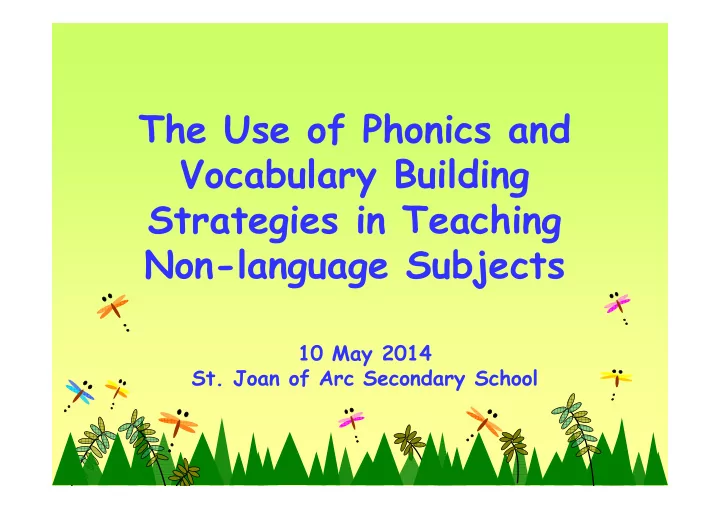

The Use of Phonics and Vocabulary Building Strategies in Teaching Non-language Subjects 10 May 2014 St. Joan of Arc Secondary School
Why phonics? 2
Phonics… • refers to a method for speakers to read and write that language • involves teaching how to connect the sounds with letters or groups of letters (e.g., the sound /k/ can be represented by c , k , ck or ch spellings) and teaching students to blend the sounds of letters together to produce approximate pronunciations of unknown words 3
Phonics… • helps students analyze the letters, letter combinations and syllables in a word; • enables students to decode or "sound-out" a word they have in their speaking vocabulary . • helps students “ encode ” unfamiliar words when they listen to a word and try to spell them out. 4
Word recognition The printed word Processing Meaning 5
Dual-route theory of written word recognition The printed word Spelling-sound Processing correspondence rules Meaning 6
Introduction of Phonics in the English Curriculum Year 1 1 phonics lesson per week in S1 and S2 conducted by NET the role of English teachers: First term: observers Second term: co-teaching with NET also embedded in daily teaching 7
Introduction of Phonics in the English Curriculum Year 2 Introduced in S1 Conducted by English teachers Embedded in daily teaching 8
Steps to teach pronunciation using phonics • Locate the vowel(s) in the word (magic e, 2-in-1) • Cut up the word • Identify the number of syllables • Sound out different parts of the word using letter-sound correspondence or small words (long and short vowel, digraph) • Blend the sounds and pronounce the word 9
How do you say this word? beginner 1. How many a, e, i, o, u do you see in this word? 2. How can you cut up this word? 3. How many syllables are there? 4. How do you say the different parts? be…gin…n er 5. Now, put them together and say the word. Listen to the teacher and say the word. 10
How do you say this word? litter 1. How many a, e, i, o, u do you see in this word? 2. How can you cut up this word? 3. How many syllables are there? 4. How do you say the different parts? l i t…t er i = short i 5 . Now, put them together and say the word. Listen to the teacher and say the word. 11
Support given to non-English teachers 1) Professional Development Workshops Service providers / universities Supported by our NET 2) Lesson observation on non-English teachers NET / English teachers are invited to be observers Post-lesson observation feedback 12
Support given to non-English teachers 3) Demonstration NET / English teachers demonstrate the use phonics in Science / Mathematics classes 4)Resource teachers NET / English teachers act as resource teachers 13
Limitations • English words do not have a one-to-one speech-sound to symbol relationship. Example: Single Letter / Different Sounds Apple / ˈ æp ə l/ Always / ˈɔ lwe ɪ z/ About / əˈ ba ʊ t/ Acorn / ˈ e ɪ k ɔ rn/ Artist / ˈɑ rt ɪ st/ 14
Limitations • Same Sound – Different Letters • Long vowel e • Be, tree, quay, sea, people, piece, complete, seize, key
Limitations • The many homonyms in English create difficulties for students when they try to spell words using phonics • see / sea • pair / pear • bare / bear
Limitations •which ‘e’? •stress? • Phonics skills may not help students in areas like stress and intonation. r e cord (n.) Vs r e cord (v.) 17
Recommendations • Raise students’ awareness of the unpredictable relationship between letters and sounds. • Enhance students exposure to English through reading 18
19
20
21
Vocabulary Building • translation from English to Chinese is more demanding for students when understanding new concepts. not recommended • Vocabulary building can be done through identifying things. (i.e. learning vocabulary in groups or categories but not in separate items) 22
23
Vocabulary Building • vocabulary worksheet can be designed in the form of diagram labelling instead of a table with vocabulary. 24
25
26
Ways to explain vocabulary • 1. Synonyms • 2. Antonyms • 3. Pictures • 4. Mime / Actions • 5. Sound • 6. Reality 27
Q & A Thank you! 28
Recommend
More recommend